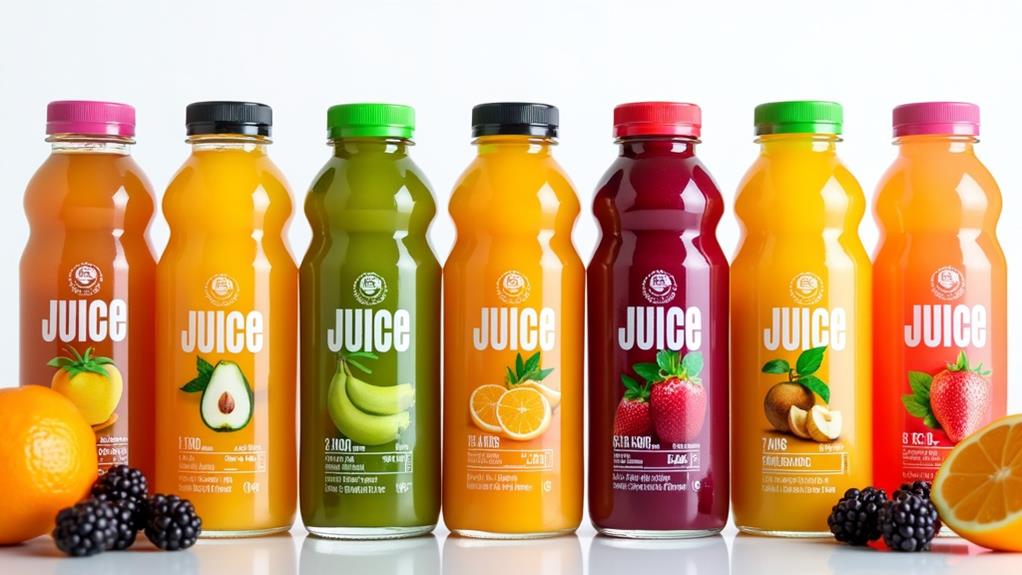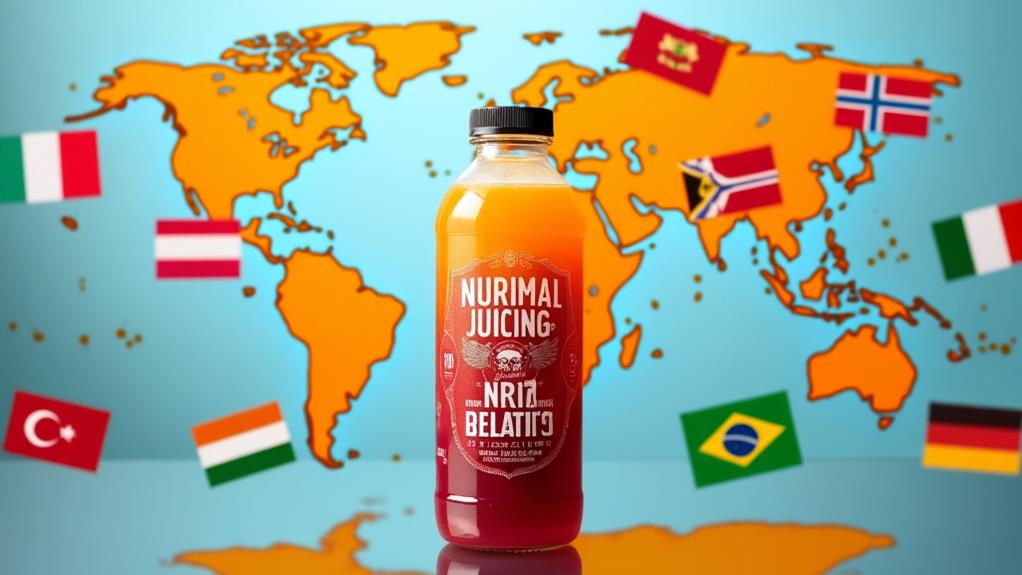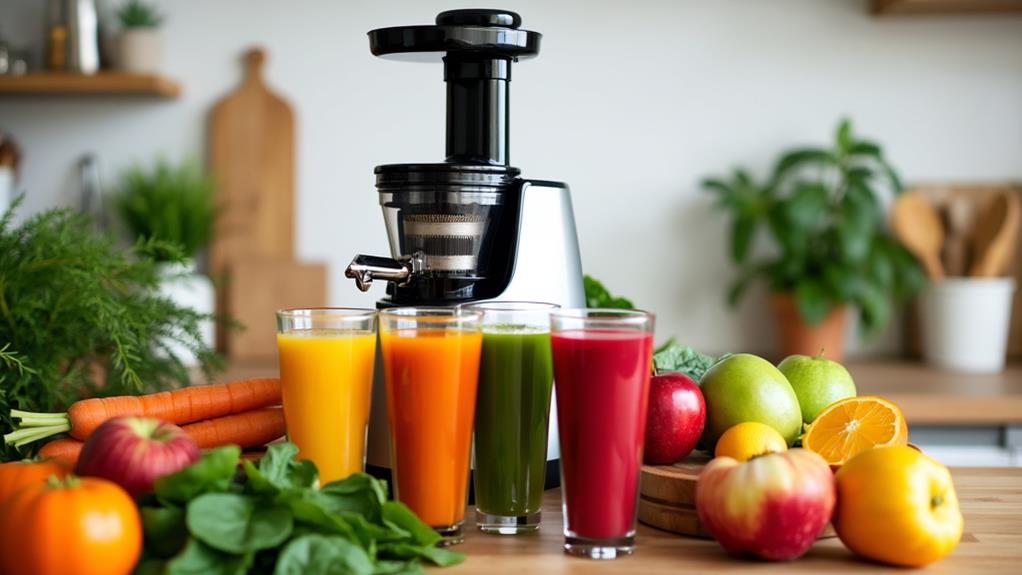Essential Guide to Juice Labeling Requirements

Navigating the intricate world of juice labeling is crucial for ensuring compliance and earning consumer trust. Key requirements include prominently displaying the production facility's name, the total juice percentage, and listing ingredients by weight. Additionally, mandatory health warnings for raw juices and allergen disclosures must be clearly visible. Even small businesses with sales under $500,000 must adhere to specific exemptions and local regulations. So, how can you ensure your labels meet these standards while appealing to consumers? Let's explore the essential elements to get right.
Labeling Guidelines and Requirements
Juice Labeling Requirements
Clarity and precision are essential for compliance with FDA regulations. When labeling your juice products, ensure the label includes the name and address of the production facility. This information allows consumers to trace the product back to its source if necessary. Additionally, prominently display the total percentage of juice for transparency.
Ingredients must be listed in descending order by weight, enabling consumers to understand the composition of the juice. If the juice is raw and unpasteurized, a bold warning statement about potential harmful bacteria is required. This warning should be enclosed in a box to ensure it is easily noticeable.
The type size for all required information must be at least 1/16 inch tall to ensure readability and compliance. Mislabeling can lead to serious consequences such as penalties or product recalls. Adhering to these guidelines maintains product integrity and ensures FDA compliance. Accurate and clear labeling is a legal requirement and a commitment to consumer well-being.
FDA Compliance and Regulations
When labeling your juice products, it is imperative to comply with FDA guidelines for nutritional information unless your business qualifies for the small business exemption. Additionally, it is crucial to disclose any potential allergens to safeguard consumers with sensitivities. Non-compliance can lead to significant penalties, so ensure your labels meet all regulatory requirements.
Nutritional Information Guidelines
Navigating FDA compliance and regulations for juice labeling may seem daunting, but understanding the essential nutritional information guidelines can help keep you compliant. Nutritional labeling is required for most juice products, except for businesses with annual gross sales of $500,000 or less, which may qualify for an exemption. Accurately stating the total percentage of juice on the label is crucial, and specific calculations are necessary when filtered water is added to determine the final juice content.
For raw and unpasteurized juice products, it is essential to include a health warning in bold type and enclosed in a box, highlighting the potential risks associated with consuming unpasteurized products. The ingredient list should display components in descending order by weight. Additionally, allergen warnings for major allergens, such as nuts, must be included if they are part of your juice products.
FDA guidelines also mandate that any health claims on your juice labels be substantiated and comply with the agency's regulations. This ensures consumer safety and transparency, making it imperative to adhere rigorously to these standards. By following these guidelines, you can ensure that your juice labels are compliant and trustworthy.
Allergen Disclosure Rules
Ever wondered how allergen disclosures impact juice labeling? The presence of major food allergens, such as tree nuts and peanuts, must be clearly disclosed on juice labels to ensure consumer safety. The FDA mandates that this allergen information be included in the ingredient declaration in a manner that is straightforward for consumers to identify.
If your juice is processed in facilities that handle allergens, a warning statement is required to alert consumers to potential cross-contamination risks. Ensuring that labels use clear and legible type sizes is essential, and allergen disclaimers should be prominently displayed to enhance visibility and prevent misbranding.
Non-compliance with these allergen disclosure regulations can have severe consequences, including product recalls and legal action. Therefore, it is critical to accurately disclose all major food allergens and any ingredients derived from these sources. By doing so, you protect consumer safety and adhere to FDA compliance requirements.
Small Business Considerations

As a small business with annual gross sales of $500,000 or less, you're exempt from federal nutritional labeling requirements, simplifying compliance. However, you must stay informed about local and state regulations to ensure full legal compliance. Partnering with local businesses can help share resources and insights, making it easier to navigate the labeling requirements effectively.
FDA Compliance Exemptions
Navigating FDA compliance can be daunting for small businesses, but there are exemptions designed to alleviate some of this burden. If your small business has annual gross sales of $500,000 or less, you are exempt from nutritional labeling requirements. This means that when preparing your juice labels, you are not required to include detailed nutritional information. Retailers with food sales not exceeding $50,000 annually also qualify for this exemption, offering some relief from stringent food labeling mandates.
However, exemptions do not eliminate all compliance obligations. You must still include ingredient declarations and allergen warnings on your juice labels to ensure consumer safety and transparency. Failure to meet these requirements can result in regulatory issues, so staying informed is crucial.
The FDA provides resources and guides specifically designed for small entities. These tools can help you navigate labeling compliance without incurring significant costs. By utilizing these resources, you can ensure that your juice labels meet all necessary standards, allowing your business to operate smoothly. Always stay updated on any changes to FDA regulations that may impact your business.
Local Regulation Awareness
Navigating local regulations is crucial for small juice businesses aiming to stay compliant and avoid costly penalties. Since local regulations can vary significantly from state to state, it's essential to pay close attention to specific labeling requirements mandated by your local health department. These requirements may include information on ingredients, allergens, and production dates.
Small juice businesses with annual gross sales of $500,000 or less benefit from exemptions on nutritional labeling requirements, simplifying compliance efforts. However, this does not mean you can ignore other local regulations. Engaging with your local health department early in your business development process helps clarify specific labeling needs and avoids potential penalties.
Community feedback can also be highly valuable. Platforms like juicing Facebook groups offer insights into what customers find appealing and compliant. This input can guide you in creating labels that meet legal standards and attract your target audience. Staying proactive in understanding and adhering to local regulations ensures your small juice business thrives while maintaining full compliance.
Collaborative Resource Utilization
Collaborative resource utilization can greatly simplify the compliance process for small juice businesses. By partnering with local enterprises, you can share resources and reduce the costs associated with meeting labeling requirements. This collaborative approach is particularly beneficial for small manufacturers or distributors of fruit or vegetable juices with annual gross sales of $500,000 or less, who are exempt from nutritional labeling but still must comply with essential food labeling standards.
Engaging in community feedback through online forums and social media groups focused on juicing can offer invaluable insights. These platforms are rich sources of best practices and real-world strategies that can help you navigate the complexities of label compliance. Additionally, establishing relationships with local health departments ensures you receive tailored guidance for your specific region's regulations.
Another effective strategy is to utilize templates and design assistance from specialized companies. These services can streamline the creation of compliant labels, ensuring you meet all mandatory standards without unnecessary hassle. Collaborating on these fronts allows you to focus more on producing quality juices rather than getting bogged down by compliance details. Ultimately, leveraging community and professional resources can help your small juice business thrive while remaining compliant.
Label Design and Production
Designing and producing juice labels involves a meticulous process to ensure compliance with local health department regulations. Your label must include all required elements, such as ingredient lists and nutritional information, with a minimum type size of 1/16 inch to ensure legibility and adherence to regulatory standards.
For label production, utilizing free online templates from companies like Avery can streamline the creation process and ensure compliance with specifications. These templates save time and confirm that all necessary elements are included. For a more unique look, custom labels are an excellent choice. These can be professionally printed or produced at home using blank sheets.
Waterproof labels are essential to withstand washing and prevent peeling, ensuring that your labels remain intact throughout distribution. If you are selling directly to consumers, consider alternative labeling methods like neck tags, which may offer more flexibility in meeting local health department requirements.
For large quantities, partnering with large print houses can be cost-effective, while smaller online suppliers offer greater flexibility for smaller batches. By paying attention to these details, you can create compliant, durable, and attractive juice labels that maintain a professional appearance for your products.
Common Inquiries and International Guidelines

Navigating juice labeling requirements can be intricate, particularly when dealing with international markets. In the U.S., juice labeling must comply with FDA regulations, which mandate listing ingredients in descending order by weight and prominently displaying the total juice percentage. For raw, unpasteurized juice, a health warning must be included in bold type within a box to highlight the risks from harmful bacteria. Non-compliance with pasteurization requirements can result in misbranding and regulatory penalties.
When exporting juice internationally, it's essential to recognize that guidelines can vary significantly. Consulting local health departments is critical to understanding each country's specific requirements. Key considerations include:
- FDA Regulations: Ensure your juice labeling meets U.S. standards before addressing international compliance.
- Health Warning: For unpasteurized juice, always include a clearly visible health warning to prevent legal complications.
- International Guidelines: Different countries have distinct rules, making direct communication with local health departments crucial for accurate labeling.
For example, in the UAE, there are no specific juice labeling guidelines, so compliance is governed by local council regulations. Always verify with health authorities for precise guidance.
Product Display Panel Essentials
Navigating international juice labeling guidelines can be complex, but ensuring compliance with product display panel essentials is equally important. On your product display panel, the product's common name, such as "juice," must be prominently displayed to ensure consumers can easily identify the product.
You must also clearly state the fluid ounces of the juice in the bottom 30% of the label, excluding the packaging to prevent any confusion. Equally crucial is displaying the manufacturer's name and address on the PDP, providing consumers with a way to contact you for inquiries or feedback, thereby enhancing trust and transparency.
For juices containing additional ingredients, you must include ingredient declarations. List these ingredients in descending order by weight to maintain clarity and honesty. Additionally, you should specify the total percentage of juice, indicating whether the product contains 100% juice or a lesser amount, which is vital for consumer awareness and adherence to labeling standards.
Information Label Components
Creating a compliant and trustworthy juice label requires including all essential information clearly and accurately. Here's a guide to ensure your label meets regulatory standards and consumer expectations:
- Ingredient Declaration: List all ingredients in descending order of weight. Transparency in ingredient listing allows consumers to understand the contents of the juice. If water is added, its percentage must be prominently displayed.
- Warning Labels: Clearly state any allergens, such as nuts. If the juice is processed in a facility that handles allergens, this must be indicated. Additionally, unpasteurized juice should feature a bold, boxed health warning to inform consumers of potential risks, thereby enhancing safety.
- Nutritional Information: Include nutritional information to provide insights into the juice's health benefits and content. Ensure this information is easy to read, with a type size of at least 1/16 inch to ensure visibility.
Optional Label Information
Including optional information on your juice labels can significantly enhance their appeal and deliver added value to consumers. While federal regulations specify mandatory inclusions, adding optional details can set your product apart in a competitive market.
For instance, incorporating the brand name, although not mandatory, is highly recommended to foster consumer recognition and loyalty. Listing the country of origin is essential for imported fruit or vegetable juices, providing transparency about the source. If your product is not pasteurized, clearly stating this information is necessary.
Additionally, you can include supplementary health claims, but they must comply with FDA guidelines to ensure they are not misleading. Including nutrition labeling, even if not required due to your business size, can be beneficial for customers who want to make informed choices. Optional graphics or certifications can enhance visual appeal but must not obscure mandatory details.
Here's a table to illustrate:
| Information Type | Benefit | Consideration |
|---|---|---|
| Brand Name | Consumer recognition | Not mandatory |
| Country of Origin | Transparency | Essential for imported products |
| Supplementary Health Claims | Added value and appeal | Must comply with FDA guidelines |
| Nutrition Labeling | Informed choices | Not required for small businesses |
| Optional Graphics | Enhanced visual appeal | Should not interfere with mandatory info |
Incorporating these elements can make your juice stand out on the shelves and offer significant information to your customers.
Label Creation Process

Starting the label creation process, ensure your juice labels comply with FDA guidelines. This includes listing the product's common name, a detailed ingredient list, and the name and address of the manufacturer. Accuracy and visibility of this information are crucial.
To streamline the process, follow these steps:
- Design Your Label: Use free online templates from providers like Avery. These templates ensure your labels meet the required size and format specifications. The minimum type size for required information should be 1/16 inch.
- Print Your Labels: For durability, choose professional printing services or online suppliers like Sticker Mule. They offer high-quality, waterproof labels that withstand washing and handling, ensuring the legibility of your product information.
- Review Local Regulations: Before finalizing your design, check local health department requirements. This ensures all mandatory information and specific local regulations are included on your juice label.
Additionally, you can enhance your label with optional features like brand names and certifications. However, ensure these additions do not compromise the clarity of the required information. By following these steps, you'll create compliant, attractive, and informative juice labels that stand out on the shelf.




